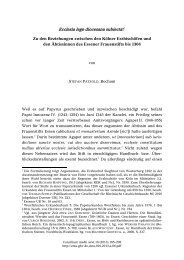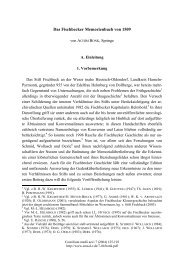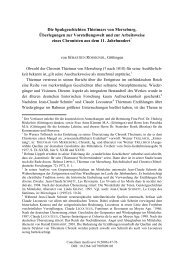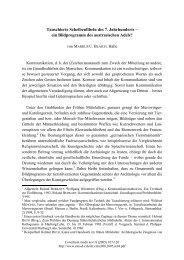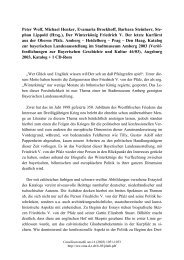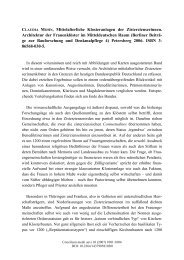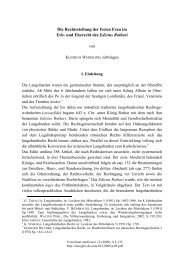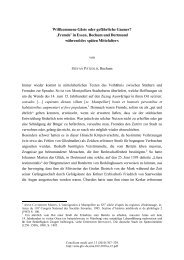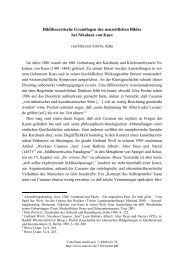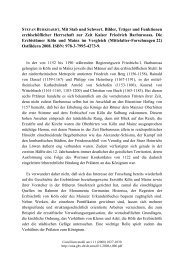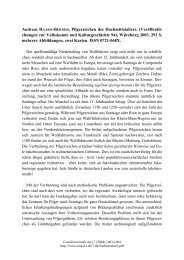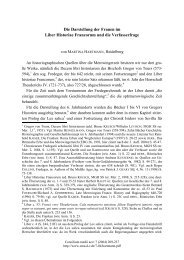Rabanus Maurus - Concilium medii aevi
Rabanus Maurus - Concilium medii aevi
Rabanus Maurus - Concilium medii aevi
Create successful ePaper yourself
Turn your PDF publications into a flip-book with our unique Google optimized e-Paper software.
Rhetoric as praise of the emperor and<br />
applied politics of an education concept.<br />
The ‘res publica litteraria’ inside the monarchy. Alcuin of York and Rhabanus<br />
<strong>Maurus</strong> as representatives of the early rhetoric in Germany during the<br />
Renaissance of Charlemagne and the manuscript Albinus ad Regem.<br />
von FEE-ALEXANDRA HAASE, Hannover<br />
This article focuses on the establishment of the early rhetoric in Germany during the<br />
‘renaissance’ of Charlemagne. Alcuin and his pupil Rhabanus <strong>Maurus</strong> were prominent<br />
persons for the establishment of rhetoric and the artes liberales. The conception of<br />
education under Charlemagne was on the one hand based upon the artes liberales. On<br />
the other hand this ‘renaissance’ of ancient education was arranged under a different<br />
political system compared with the one, which was used in Rome and Greece. So the<br />
educational concept itself contains the interest of adornment and honour of the king<br />
perfectly used in the rhetorical dialogue between the king and the scholar Alcuin of<br />
York and the works of the first ‘Praeceptor Germaniae’ Rhabanus <strong>Maurus</strong>. The<br />
common term ‘Carolingian Renaissance’ refers to this culture of learning in the late 8 th<br />
century. Discussing the political function of the artes liberales with a special emphasis<br />
on the status of rhetoric and the manuscript Albinus ad Regem we see, how the ‘res<br />
publica litteraria’ inside the monarchy worked.<br />
In 800 the Frankish king Charlemagne became crowned emperor of the West.<br />
Charlemagne was a strong leader who unified Western Europe through military power<br />
and the blessing of the Church. Charlemagne saw the need for education of the<br />
Frankish people and started reforms for religious, political, and educational issues.<br />
Charlemagne – considered being himself a ‘homo illiteratus’ – promoted this<br />
educational goal by using himself as an example of a scholar of ancient culture at the<br />
top of the system and achieving the ability to read and write Latin and Greek. The time<br />
of Charlemagne was a period of great activity in the areas of later France and<br />
Germany.<br />
Charlemagne asked Alcuin to act as the head of the school system. While returning<br />
from Rome in March 781, Alcuin met Charlemagne at Parma, and moved to France<br />
and took up residence at the royal court as Master of the Palace School. The school<br />
was kept at the main place of the residence of the king, Aachen, most of the time. It<br />
<strong>Concilium</strong> <strong>medii</strong> <strong>aevi</strong> 8 (2005) 1-25<br />
http://www.cma.d-r.de/dr,cma,008,2005,a,01.pdf
2<br />
FEE-ALEXANDRA HAASE: Rhetoric as praise of the emperor<br />
was removed from place to place according to the change of the royal residence. In<br />
786 and again 790-793 Alcuin returned to England. Alcuin remained in France from<br />
the summer of 793 until his death, May 19, 804. Alcuin was an educator, scholar, and<br />
theologian. Alcuin’s educational writings are the treatises On Grammar, On<br />
Orthography, On Rhetoric and the Virtues, On Dialectics and the Disputation with<br />
Pepin. 1 In other words: The educational works consist of works dedicated for the<br />
trivium like De grammatica, De dialectica, De rhetorica and a fragment concerning<br />
music, De orthographia and the dialogue Disputatio Pippini cum Albino scholastico.<br />
The writings of Priscian, Donatus, Isidorus and Beda for grammar, of Cicero for<br />
rhetoric and from Augustine for dialectics were used by Alcuin. The language of<br />
Carolingian culture for the church and bureaucracy was Latin. For most people in<br />
Europe after the ‘barbarian invasions’ Latin was a foreign language. Charlemagne<br />
encouraged literacy in Latin, his own clergy being helped in this work by Anglo-Saxon<br />
and Irish monks, who had already had to develop methods of teaching Latin as a<br />
second language. Carolingian scholars made the copies of the Latin classics, which the<br />
humanists later discovered.<br />
According to Einhard (Eginhard), the Disputationes, and Alcuin’s correspondence,<br />
Charlemagne listened to his Anglo-Saxon advisor in all matters not political.<br />
Charlemagne’s Admonitio generalis stressed the importance of education. The<br />
academic scholars working at his court developed a concept based upon the ancient<br />
artes liberales. Among the clergy many of them were barely literate. Monks who spent<br />
their days copying manuscripts could barely read or understand them. Charlemagne<br />
wanted unity in the Frankish Church under his supervision. By this time the state<br />
needed the monastery schools to teach civic lessons in addition to Christian coverage.<br />
Einhard writes in the Vita Karoli Magni that eloquence was to be expressed in foreign<br />
languages and Charlemagne learned Greek and Latin:<br />
[25] Erat eloquentia copiosus et exuberans poteratque quicquid vellet apertissime<br />
exprimere. Nec patrio tantum sermone contentus, etiam peregrinis linguis ediscendis<br />
operam impendit. In quibus Latinam ita didicit, ut aeque illa ac patria lingua orare sit<br />
solitus, Grecam vero melius intellegere quam pronuntiare poterat. Adeo quidem<br />
facundus erat, ut etiam dicaculus appareret. 2<br />
1 http://www.newadvent.org/cathen/01276a.htm. [5.8.2002]<br />
2 http://www.gmu.edu/departments/fld/CLASSICS/ein.html#25. [3.9.2003]
FEE-ALEXANDRA HAASE: Rhetoric as praise of the emperor<br />
Charles had the gift of ready and fluent speech, and could express whatever he had<br />
to say with the utmost clearness. He was not satisfied with command of his native<br />
language merely, but gave attention to the study of foreign ones, and in particular was<br />
such a master of Latin that he could speak it as well as his native tongue; but he could<br />
understand Greek better than he could speak it.<br />
Einhard writes in the Vita Karoli Magni about the method of learning of the king:<br />
Temptabat et scribere tabulasque et codicellos ad hoc in lecto sub cervicalibus<br />
circumferre solebat, ut, cum vacuum tempus esset, manum litteris effigiendis<br />
adsuesceret, sed parum successit labor praeposterus ac sero inchoatus. 3<br />
He also tried to write, and used to keep tablets and blanks in bed under his pillow,<br />
that at leisure hours he might accustom his hand to form the letters; however, as he<br />
did not begin his efforts in due season, but late in life, they met with ill success.<br />
The biography written by Einhard is in general considered as a problematic source,<br />
since it obviously is not a historically objective source. But the text cited above gives<br />
us a good sample to discuss the function of ‘political literature’ of that time. On the<br />
one hand the author had the intention to promote the king’s authority and to put him on<br />
top of the educational system. This, of course, is also a common topos of philosophy<br />
going back to the sentence ‘kings to philosophers and philosophers to kings’<br />
mentioned by Socrates in The Republic, when discussing the ideal republic. Of course,<br />
in the concept used by Einhard the idea of the ideal republic is used for the idea, which<br />
later on became prominent as the ‘res publica litteraria’ in the 18 th century. A common<br />
topos in the literature written in the time of Charlemagne is that the king was educated<br />
according to the system he promoted. Einhard says in his vita of Charlemagne that the<br />
king had the gift of a ready and fluent speech and could express whatever he had to<br />
say with the utmost clearness. The king wasn’t satisfied with command of his native<br />
language merely, but gave attention to the study of foreign ones. According to Einhard<br />
Charlemagne was such a master of Latin that he could speak it as well as his native<br />
tongue; according to Einhard the king could understand Greek better than he could<br />
speak it. Einhard, although illiterate as a youth, presented Charlemagne, as fascinated<br />
by new ideas and to learning. Charlemagne studied subjects of the artes liberales such<br />
as Latin, Greek, rhetoric, logic and astronomy. Charlemagne was – according to<br />
3 http://www.gmu.edu/departments/fld/CLASSICS/ein.html#25. [3.9.2003]<br />
3
4<br />
FEE-ALEXANDRA HAASE: Rhetoric as praise of the emperor<br />
Einhard’s description – so eloquent, that he might have passed for a teacher of<br />
eloquence. We must consider these statements as part of the political ideology of that<br />
time and a praise of the king and following certain traditions of scholarly knowledge<br />
mentioned above. The realisation of this concept by using the ancient education<br />
system based upon the liberal arts. Einhard describes in Life of Charlemagne (25)<br />
Charlemagne as the mentor and cultivator of the artes liberales:<br />
Artes liberales studiosissime coluit, earumque doctores plurimum veneratus magnis<br />
adficiebat honoribus. In discenda grammatica Petrum Pisanum diaconem senem<br />
audivit, in ceteris disciplinis Albinum cognomento Alcoinum, item diaconem, de<br />
Brittania Saxonici generis hominem, virum undecumque doctissimum, praeceptorem<br />
habuit, apud quem et rhetoricae et dialecticae, praecipue tamen astronomiae<br />
ediscendae plurimum et temporis et laboris inpertivit. Discebat artem conputandi et<br />
intentione sagaci siderum cursum curiosissime rimabatur. 4<br />
He most zealously cultivated the liberal arts, held those who taught them in great<br />
esteem, and conferred great honors upon them. He took lessons in grammar of the<br />
deacon Peter of Pisa, at that time an aged man. Another deacon, Albin of Britain,<br />
surnamed Alcuin, a man of Saxon extraction, who was the greatest scholar of the day,<br />
was his teacher in other branches of learning. The King spent much time and labor<br />
with him studying rhetoric, dialectics, and especially astronomy; he learned to reckon,<br />
and used to investigate the motions of the heavenly bodies most curiously, with an<br />
intelligent scrutiny.<br />
According to the image of the philosophically educated king, which goes back to<br />
the Platonic idea of the sovereign as philosopher, Charlemagne joined the school of<br />
Alcuin, attended classes, and fulfilled his scholarly duties. In the school system of<br />
Charlemagne a text was read by a student or teacher accompanied by an explanation.<br />
So the genre dialogue is typical for the teaching system at that time. A master lectured<br />
on various subjects and there was a ‘disputation’. The student would be asked a<br />
multitude of questions and was forced to defend his position with logical arguments.<br />
This method of teaching was responsible for students learning to discipline their<br />
thoughts in Charlemagne’s day, and under the kings who followed, which used the<br />
canon of the artes liberales. 5<br />
4 http://www.noctes-gallicanae.org/Alcuin/Alcuin_epitaphe.htm. [3.9.2003]<br />
5 The text Caroli regis contra synodum from the 790s, traditionally called Libri Carolini, is written in<br />
opposition to the Byzantine empire and its rulers Irene and Constantine. Ommundsen investigated
FEE-ALEXANDRA HAASE: Rhetoric as praise of the emperor<br />
Compared to the artes liberales education in the ancient Roman time during the<br />
Middle Ages and Renaissance rhetoric – like other sciences of the system – was a tool<br />
for the access to theology and philosophy. Since the seven liberal arts of the trivium of<br />
grammar, rhetoric, and logic and the quadrivium of arithmetic, geometry, astronomy,<br />
and music were the ground for the access to philosophy and theology, a hierarchy<br />
existed according to contemporary political and social circumstances. 6 Students began<br />
their career in the faculty of arts. There they studied grammar, rhetoric and logic<br />
(trivium) next to arithmetic, astronomy, geometry and music (quadrivium). 7<br />
Isidore and Alcuin wrote an encyclopaedia of human knowledge, which included<br />
rhetoric and dialectic. Alcuin made a treatise on legal procedure in the form of a<br />
dialogue. Alcuin less describes in his book De Disputatio de Rhetorica et de virtutibus<br />
sapientissimi regis Carli et Albini Magistri rhetoric at the court of Charlemage;<br />
furthermore it is a propagandistic writing. So in the introduction Alcuin says that the<br />
one who desires to know the civil customs (civil customs) shall read the teachings<br />
(praecepta), which the book contains and which were written at the court of<br />
Charlemange who gave his ‘placet’ for it (ille probat) in this fictional pretext of coauthorship:<br />
Qui rogo civiles cupiat cognoscere mores,<br />
Haec praecepta legat, quae liber iste tenet.<br />
Scripserat haec inter curas rex Karulus aulae<br />
Albinusque simul: hic dedit, ille probat.<br />
Unum opus amborum, dispar sed causa duorum:<br />
Ille pater mundi, hic habitator inops.<br />
Neu temnas modico lector pro corpore librum:<br />
Corpore praemodico mel tibi portat apis. 8<br />
avout the role of the liberal arts in the Opus Caroli Regis: Å. OMMUNDSEN, The Liberal Arts and the<br />
Polemic Strategy of the Opus Caroli Regis Contra Synodum (Libri Carolini), in: Symbolae Osloenses.<br />
77/ 1 (2002) Pp. 175-200.<br />
6<br />
Cf.: Renaissance literary theory and practice. Classicism in the rhetoric and poetic of Italy, France,<br />
and England 1400-1600. Ed. with introduction by D.L. CLARK. 1939, Pp. 87-94.<br />
7<br />
C.D. LANHAM, Latin grammar and rhetoric from classical theory to medieval practice. 2002, Pp. 57-<br />
70.<br />
8<br />
http://www.gmu.edu/departments/fld/CLASSICS/alcuin.rhetorica.html. [9.6.2004]<br />
5
6<br />
FEE-ALEXANDRA HAASE: Rhetoric as praise of the emperor<br />
Important is here the fact that it is a writing getting its note of approval by<br />
censorship of the king. The text itself is according to the fact that it was written by<br />
Alcuin and accepted by Charlemagne not an authentic dialogue. The Disputatio de<br />
rhetorica et de virtutibus sapientissimi regis Carli et Albini magistri is the debate of<br />
the wise king and the teacher Alcuin about rhetoric and the virtues. As a moralizing<br />
political treatise the dialogue between Charlemagne and Alcuin the speakers describes<br />
that the proper subjects of rhetoric are politics, law and morals. The final section of the<br />
four cardinal virtues ends with honouring sentences for the king. 9 The sixteen chapters<br />
of the dialogue between the questioning pupil Charlemagne and the master Alcuin<br />
base on writings of Cassiodorus, Boethius, Cicero, Marius Victorinus, Julius Victor,<br />
Quintilian, and Pseudo-Augustine. The work distinguishes rhetoric as the art of<br />
disputation on practical matters from dialectic as the art of disputation on theoretical<br />
matters (theology). 10 The work On Rhetoric (Disputatio de rhetorica et de virtutibus<br />
sapientissimi regis Carli et Albini magistri) is a moralizing political treatise in form of<br />
a dialogue between Charlemagne and Alcuin. The dialogue closes with a final section<br />
on the four cardinal virtues. The sixteen chapters of dialogue between the questioner<br />
Charlemagne and the master Alcuin are based on Cassiodorus, Boethius, Cicero,<br />
Marius Victorinus, Julius Victor, Quintilian, and Pseudo-Augustine. Texts by the<br />
Church Fathers such as the Confessions by St. Augustine dealing with rhetoric issues<br />
were known to Alcuin. Alcuin’s Disputatio Pippini regalis et nobilissimi iuvenis cum<br />
Albino scholastico Alcuinus is a sample for the didactical literature of Alcuin in form<br />
of a dialogue. Although Alcuin’s importance as a central intellectual figure in the<br />
Carolingian Renaissance has never been seriously questioned, the quality of his<br />
literary production can be considered only part of the reason for his importance. His<br />
contemporary and rival Theodulf called him ‘nostrorum gloria vatum’. A letter to<br />
Aethilhard (Ep. 311) is evidence that Alcuin was still writing poetry at least as late as<br />
802. 11<br />
9 A first modern edition was made in 1841: Flaccus Alcuinus, The rhetoric of Alcuin and<br />
Charlemagne. A translation, with an introduction, the Latin text, and notes. 1941.<br />
10 See also: Introduction of: W.S. HOWELL, The rhetoric of Alcuin and Charlemagne. A translation.<br />
1941; A.F. WEST, Alcuin and the rise of the Christian schools. 1892 (Reprint 1969); H.V. FRIEDMAN,<br />
Rhetoric of Alcuin and Charlemagne (Howell), in: Classical Weekly (1942) Pp. 21-39, P. 25ff.<br />
11 P.D. SCOTT, Alcuin as a Poet. Rhetoric and Belief in his Latin Verse, in: University of Toronto<br />
Quarterly XXXIII (1964) Pp. 233-257; W. WILMANNS, Disputatio regalis et nobilissimi juvenis<br />
Pippini cum Albino scholastico, in: Zeitschrift für deutsches Altertum 14 (1869) Pp. 530-555;<br />
http://ub.leidenuniv.nl/bc/whs/catalogi/catcomp1/01.html. [15.9.2003]; Editions of Alcuin’s De<br />
Rhetorica: K. HALM, Rhetores Latini Minores, ex codicibus maximam partem primum adhibitis. 1863,<br />
Pp. 523-550.
FEE-ALEXANDRA HAASE: Rhetoric as praise of the emperor<br />
Alcuin introduced with his Disputatio de rhetorica et virtutibus the definition of<br />
rhetoric in a dialogue between him and Charlemagne:<br />
K. Unde dicta est rhetorica?<br />
K. Where does ‘rhetoric’ come from?<br />
A. Apo tou retoreuein, id est copia locutionis.<br />
A. ‘ Apo tou retoreuein’, this is the variety of speaking.<br />
K. Ad quem finem spectat?<br />
K. What is its purpose?<br />
A. Ad bene dicendi scientiam.<br />
A. The art of good speaking.<br />
K. In quibus versatur rebus?<br />
K. To which things is it related?<br />
A. To civil things, these are scholary questions […].<br />
A. In civilibus, id est doctis quaestionibus […]. 12<br />
Alcuin invoces the king with the words Dominus rex Karlus:<br />
A. Deus te, domine mi rex Karle, omni sapientiae lumine inluminavit et scientiae<br />
claritate ornavit, ut non solum magistrorum ingenia prompte subsequi, sed etiam in<br />
multis velociter praecurrere possis. 13<br />
A. God enlightened you, my master King Charles, with the light of total wisdom and<br />
decorated you with the clearness of science, so that you not only are able to follow<br />
immediately the intellect of the teachers, but also are able to proceed in many. 14<br />
In the Epistola de litteris colendis (784/85), for which Charlemagne is considered<br />
being the author, the docendi et discendi instantia is mentioned:<br />
12<br />
K. WERNER, Alcuin und sein Jahrhundert. Ein Beitrag zur christlich-theologischen<br />
Literaturgeschichte. 1876, Pp. 12ff.<br />
13<br />
http://freespace.virgin.net/angus.graham/Alcuin.htm. [2.2.2004]<br />
14<br />
http://freespace.virgin.net/angus.graham/Alcuin.htm. [2.2.2004]<br />
7
8<br />
FEE-ALEXANDRA HAASE: Rhetoric as praise of the emperor<br />
[...] ita quoque docendi et discendi instantia ordinet et ornet seriem verborum, ut,<br />
qui deo placere appetunt recte vivendo, ei etiam placere non neglegant recte<br />
loquendo. scriptum est enim: aut ex verbis tuis iustificaberis, aut ex verbis tuis<br />
condemnaberis (Matth. 12,37). quamvis enim melius sit bene facere quam nosse, prius<br />
tamen est nosse quam facere. debet ergo quisque discere, quod optat implere, ut tanto<br />
uberius, quid agere debeat, intellegat anima, quanto in omnipotentis dei laudibus sine<br />
mendaciorum offendiculis concurrerit lingua. 15<br />
For the trivium Alcuin chose the genre of the didactic dialogue to arrange the<br />
classical knowledge of ancient times in a new form. Alcuin’s Dialectica is structured<br />
the way the dialogue about the rhetoric is composed. Alcuin wrote five didactic works.<br />
All except one have the form of a dialogue. This form illustrates that many of his<br />
writings are used for the needs of his students. The Platonic tradition of the dialogue as<br />
method of education was renewed restoring the study of the liberal arts in Europe. The<br />
Ars grammatica consists of two parts: a conversation between Alcuin and his students;<br />
the grammar, in which a 14-year old Frankish pupil and a 15-year old Saxon pupil<br />
concern themselves mainly with morphology and etymology. De Orthographia is an<br />
alphabetical list of words, based mainly on Bede's De orthographia. The Disputatio de<br />
rhetorica et de virtutibus sapientissimi regis Carli et Albini magistri, The debate of the<br />
wisest king Charles and the teacher Alcuin, about rhetoric and the virtues is a<br />
moralizing political treatise, is a dialogue between Charlemagne and Alcuin.<br />
According to the edition of J.-P. Migne Alcuin’s work consists of letters, Exegetica,<br />
Dogmatica, Liturgica et Moralia, Hagiographica, poems such as inscriptions,<br />
epitaphia, epigrammata and Didascalia such as the writings Grammatica, De<br />
orthographia, Dialogus de rhetorica, De dialectica Pippini Regalis et nobilissimi<br />
juvenis disputatio cum Albino Scholastico. Dubia are Joannis Mabillonii disquisitio de<br />
antiquitate et auctore confessionis fidei sequentis Albini Confessio fidei Disputatio<br />
puerorum per interogationes et responsiones, Propositiones Alcuini doctoris ad<br />
acuendos juvenes Scripta alia nonnulla Alcuino dubitanter ascripta. On Computation<br />
was written in 820. 16 Alcuin composed more than 120 poems in hexameters, distichs,<br />
adonics with alliteration similar to that of Old English vernacular verse, sapphics, and<br />
15 Bibliotheca Augustana:<br />
http://www.fh-augsburg.de/~harsch/Chronologia/Lspost08/CarolusMagnus/kar_epli.html. [2.2.2004]<br />
16 Peter Dale SCOTT, Alcuin as a Poet. Rhetoric and Belief in his Latin Verse, in: University of<br />
Toronto Quarterly 33/3 (1964), Pp. 233-245, Pp. 235-250, P. 240f.
FEE-ALEXANDRA HAASE: Rhetoric as praise of the emperor<br />
freer liturgical forms, in a range of genres that included letters, history, hagiography,<br />
epitaphs, epigraphs, manuscript inscriptions or subscriptions, riddles, carmina figurata,<br />
prayers, nature poems, liturgy, poems on literary subjects, hymns, and more. One of<br />
the extant works is Coena’s epitaph in verse, but the next is the vast poem on York, so<br />
that his first compositions include his grandest and most impressive. A letter to<br />
Aethilhard is evidence that Alcuin was still writing poetry at least as late as 802. 17 This<br />
is another piece in the form of a dialogue between a master and his disciple. Much of it<br />
was copied from Bede’s De temporum ratione, Isidore’s Etymologies, and Boethius’<br />
Arithmetic. The resulting work marked an advance in instruction in the important<br />
matter of computing numbers, times and seasons. Isidorus Hispalensis dedicated the<br />
first and second book of the De etymologiarum libri XX to the trivium:<br />
Liber I De grammatica<br />
Liber II De rhetorica et dialectica<br />
Liber III De quatuor disciplinis mathematicis<br />
Liber IV De medicina<br />
Alcuin’s treatise on legal procedure was written in the form of a dialogue. Sprahha<br />
(eloquentia) is the Middle German language term for eloquence. Alcuin wrote in De<br />
Disputatio de Rhetorica about the parts of rhetoric according to the ancient scheme:<br />
Artis rhetoricae partes quinque sunt: inventio, dispositio, elocutio, memoria. 18 While<br />
Church Father Isidorus in his Etymologiarum libri XX simply tells the rhetorical<br />
categories, Alcuin adds examples taken from the Bible. So Isidore says ‘genera<br />
causarum tria sunt, deliberativum, demonstrativum, iudiciale’ (caput IV, 1), while<br />
Alcuin adds examples for each genus. Alcuin also mentions the three genres (genera)<br />
of speech (1.5) in his work De Rhetorica:<br />
17 http://freespace.virgin.net/angus.graham/Alcuin.htm. [2.3.2004]<br />
As secundary literature see: G. BAESECKE, Die Karlische Renaissance und das deutsche Schrifttum,<br />
in: Deutsche Vierteljahresschrift für Literaturwissenschaft und Geistesgeschichte 23 (1949) Pp. 178-<br />
181, 367.2; P. GODMAN, Poets and Emperors: Frankish Politics and Carolingian Poetry. 1987, Pp.<br />
25ff.; C. LEONARDI, Alcuino e la scuola palatina, in: Nascita dell’Europa carolingia. Un equazione da<br />
verificare, Settimane 27 (1981) Pp. 459-496; J.I. MCENERNEY, Alcuin, Carmen 58, in:<br />
Mittelateinisches Jahrbuch 16 (1981) Pp. 35-42; D. SCHALLER, ‘Alcuin’, in: Die deutsche Literatur<br />
des Mittelalters. Verfasserlexikon 1. Ed. by K. RUH et al. 1978, Cols. 241-53, Pp. 35-40ff.; P.D.<br />
SCOTT, Alcuin as a Poet: Rhetoric and Belief in his Latin Verse, in: University of Toronto Quarterly<br />
XXXIII (1964) Pp. 233-257. In Leiden, Library of the University, we find a manuscript: Disputatio<br />
Karoli regis et Albini (Alcuini) magistri sui de dialectica et virtutibus (fol. 61r-74r) 3. Sermones duo<br />
(fol. 74r-88v) 4. Tractatus de unione, quaestiones et responsa (fol. 89r-103r).<br />
18 http://www.gmu.edu/departments/fld/CLASSICS/alcuin.rhetorica.html. [5.8.2002]<br />
9
10<br />
FEE-ALEXANDRA HAASE: Rhetoric as praise of the emperor<br />
Ars rhetorica in tribus versatur generibus, id est demonstrativo, deliberativo et<br />
iudiciali. Demonstrativum genus, quod tribuitur in alicuius certae personae laudem<br />
vel vituperationem, ut in Genesi de Abel et Cain legitur: Respexit dominus ad Abel et<br />
ad.munera eius, ad Cain autem et munera eius non respexit. Deliberativum est in<br />
suasione et dissuasione, ut in Regum legitur, quomodo Achitophel suasit David citius<br />
perdere, et quomodo Chusai dissuasit consilium eius, ut regem salvaret. Iudiciale est,<br />
in quo est accusatio et defensio, ut in actibus legimus Apostolorum, quomodo Iudaei<br />
cum Tertullo quodam oratore Paulum accusabant apud Felicem praesidem, et<br />
quomodo Paulus se defendebat apud eundem praesidem. Nam in iudiciis saepius quid<br />
aequum sit quaeritur, in demonstratione quid honestum sit intellegitur, in<br />
deliberatione quid honestum et utile sit consideratur. 19<br />
The art of rhetoric is in three genres divided, these are the genus demonstrativum,<br />
the genus deliberativum and the genus judicale. The genus demonstrativum, in which<br />
praise or blame is dedicated to a person, like we red in the Genesis about Abel and<br />
Cain: The Lord had respect for Abel and his works, but for Cain the Lord had no<br />
respect. The genus deliverativum is related to suasion and dissuasion, just like we read<br />
in Kings how Achitophel suaded David to further perishing, and how Chusai dissuade<br />
his plan to save the king. The genus judicale is the one for accusations and defences,<br />
just like we read in the documents of the Apostles, how the people of Iudaea accused<br />
Paul with the help of an orator called Tertullus under the supervision of Felix, and<br />
how Paulus defended himself under this superivision. Because often in judgements is<br />
asked about equality, in a demonstration one thinks about what is honest and in a<br />
deliberation what is honest and usable.<br />
In his work De Rhetorica (1.4.) Alcuin mentions the parts of rhetoric:<br />
Artis rhetoricae partes quinque sunt: inventio, dispositio, elocutio, memoria,<br />
pronuntiatio. Inventio est excogitatio rerum verarum aut verisimilium, quae causam<br />
probabilem reddant: dispositio est rerum inventarum in ordinem distributio: elocutio<br />
est idoneorum verborum ad inventionem accommodatio: memoria est firma animi<br />
rerum ac verborum A.D. inventionem perceptio: pronuntiatio est ex rerum et verborum<br />
dignitate vocis et corporis moderatio. 20<br />
19 http://www.freespace.virgin.net/angus.graham/Alc-Rhet.htm. [5.8.2002]<br />
20 http://freespace.virgin.net/angus.graham/Alcuin.htm. [5.8.2002]
FEE-ALEXANDRA HAASE: Rhetoric as praise of the emperor<br />
In the art of rhetoric the five parts are: Invention (inventio), disposition (dispositio),<br />
elocution (elocutio), memory (memoria), delivery (pronuntiatio). The inventio is the<br />
finding of true things or things that appear true that lead to the causa probabilis,<br />
dispositio is the distribution of the invented things in a scheme. Elocutio is the<br />
accommodation of the accurate words for the invention. Memoria is the solid<br />
perception of things and words in the mind. Delivery is the moderation of the coice<br />
and body from the dignity of things and words.<br />
For the question of the relation between the king and Alcuin the document Albinus<br />
ad regem is very interesting. The document is a letter of advice in Latin; the first part<br />
is a plain text and the second part put in the scheme of the majuscules A and L. A<br />
codex now in Köln (Köln, Dombibliothek, Codex 106. Darmst. 2106) is a very<br />
interesting manuscript concerning the relation between the scholar Alcuin and the<br />
king. Written about 810 at Werden a. d. Ruhr in the Benediktinerabtei St. Ludger in<br />
Latin in Carolingian minuscules the codex contains in Fol. 2r-59v copies of Alcuin:<br />
Enchiridion (including Fol. 5v De octo vitiis principalibus, Fol. 17r-17v Versus de<br />
contemptu mundi, Fol. 22r-22v Orationes de septem psalmis poenitentialibus, Fol.22v<br />
De oratione dominica, Fol. 23r-26v Alcuinus: Epistola ad pueros sancti Martini de<br />
confessione peccatorum, Fol. 26v Ad regem, Fol. 44r Hymni, Fol. 44v-45r. The<br />
manuscript Ad regem contains no paragraph signs. Words do not close up with line<br />
endings.<br />
Albinus Ad Regem<br />
Fuganda sunt omnimodis et abscidenda ac ferro totoque<br />
artificio separanda: Languor a corpore, imperi-<br />
tia ab animo, luxoria a ventre, a civitate sedicio,<br />
a domo discordia et in commune a cunctis rebus<br />
intemperantia. Amicorum debent esse cuncta com-<br />
munia. Duorumque temporum maxime haben-<br />
da cura mane et vespere: et eorum qui aucturi su-<br />
mus et eorum quae gesserimus. Post deum veritas<br />
maxime colenda.<br />
In the letter Albinus ad regem the king is advised, that the following habits are to be<br />
avoided (fuganda sunt ) in any way:<br />
Inactivity from the body<br />
11
12<br />
FEE-ALEXANDRA HAASE: Rhetoric as praise of the emperor<br />
Ignorance from the mind<br />
Abundance from the stomach<br />
Dissension from citizenship<br />
Disagreement from the home<br />
and in the community extravagance from all things.<br />
Furthermore, the king is advised that all of the friends has to be common. Special<br />
emphasis he puts on the two times morning and evening and finally closes the letter<br />
with the notice, that after god the truth (veritas) is mostly to collect.<br />
This riddle follows the text of the letter:<br />
A stateram ne transilias<br />
F id est iusticiam ne proptergradiaris<br />
A (i)gnem gladio ne fodias<br />
F id est iratum videlicet verbum maledicis lacessias<br />
A coronam minime carpas<br />
F id est leges urbium conserves<br />
A cor non comedas<br />
F id est merorem de animo proiece<br />
A cum profectus fueris ne redeas<br />
F id es post mortem vitam istam ne desideras<br />
A per viam publicam ne ambules<br />
F (id est) multorum errores non sequaris<br />
A hirundinem in domo ne suscipias<br />
F id est garrulos et verbosos homines sub eodem tecto non habeas<br />
A oneratis onus suppone<br />
(F) id est ad virtutem incedentibus auge praecepta<br />
A deponentibus non communices<br />
F id est tradentibus se otio relinque 21<br />
Since the text is a copy and so does not contain any criteria for the time of the<br />
writing, we can only look at the contents and style of the text: The letter is addressed<br />
finally to an unknown person, only the title indicates the king and Alcuin. In<br />
opposition to Alcuin’s written documents, which relay to the artes liberales, this<br />
document is only concerned with ethical questions and has a very pragmatic focus on<br />
them. These general advices are in their style and quality directed towards a person in<br />
21 The text taken from Dom.-Hs 106, Fol. 26v was edited at: Archiv der Gesellschaft für ältere<br />
deutsche Geschichtskunde 7 (1839) Pp. 857-858.
FEE-ALEXANDRA HAASE: Rhetoric as praise of the emperor<br />
a higher or even the highest position, but also contain advises for general lifeconduction.<br />
Derived from Secundus Symphosius and an anonymously written disputation<br />
between Hadrian and Epictetus, the Disputatio regalis et nobilissimi juvenis Pippini<br />
cum Albino scholastico (The dispute of the royal and most noble young man Pippin<br />
with the teacher Albinus) provides another pedagogical dialogue, this time with the<br />
son of Charlemagne. The main didactic method used by Alcuin was the question and<br />
answer scheme. We find this in the teachings and in the dialogues. It can be considered<br />
as a rhetorical concept. The dialogue between Pippin and Alcuin is composed in<br />
question and answer. If we compare now the dialogues between Pippin and Alcuin as<br />
well as between Charlemagne and Alcuin, we first have to ask about their origin, time,<br />
purpose and authenticity. So the first dialogue could have been only homage to Pippin<br />
later made by his son Charlemagne in order to establish him in the annals as the<br />
legitimate emperor following Pippin. 22 While we find as topic of the dialogue between<br />
Pippin and Alcuin the definition of main elementary things such as things and abstract<br />
values in an encyclopaedic approach, which establishes his text in one tradition of<br />
educational literature with Comenius’ Orbis pictus, the dialogue with Charlemagne<br />
focuses only on rhetoric in the tradition of the ancient rhetorical concepts and allows<br />
derivations only as exempla. Alcuin invokes Charlemagne with the title ‘rex’ and is<br />
respected by the king for his ability to open the subtle value of rhetoricae artis vel<br />
dialecticae. In the dialogue with Pippin no special invocation of the king is made. So<br />
this demonstrates the importance of the dialogues to represent the king Charlemagne,<br />
while Pippin is the basic elementary background expressed with the encycopedic<br />
approach of the text. His son is object of rhetorical honor when Alcuin says, that God<br />
made Charlemagne great (magnus) and beautiful (beatus): ‘Magnum te faciat Deus et<br />
vere beatum, domine mi rex […].’<br />
22 For the editorial history of Pippini Regalis et Nobilissimi Juvenis Disputatio cum Albino Scholastico<br />
see: A text edition of Pippini Regalis et Nobilissimi Juvenis Disputatio cum Albino Scholastico was<br />
made by Jean Lauand: Pippini Regalis et Nobilissimi Juvenis Disputatio cum Albino Scholastico (PL<br />
101, 975-980). One copy of the Disputatio Pippini cum Alcuino is the Ms 808 in the Österreichische<br />
Nationalbibliothek, Vienna. Pippini Regalis et Nobilissimi Juvenis Disputatio cum Albino Scholastico<br />
(PL 101, 975-980). Monitum pr<strong>aevi</strong>um. Cl. Quercetanus Disputationem quae sequitur edidit juxta<br />
exemplar impressum Hamburgi anno 1615. In codice ms. Salisburgensi 900 annorum eadem<br />
Disputatio exstat media inter epistolas et carmina Alcuini, absque tamen auctoris nomine; e quo<br />
lectiones variantes adnotavimus. Modern print editions: Philosophus Secundus; Publius Aelius<br />
Hadrianus; Epictetus; Albinus Diaconus, Altercatio Hadriani Aug. et Epicteti philosophi; Item<br />
Disputatio Pippini et Albini scholastici. Haer nova; illa auctior prodit. Ed. H. LINDENBROG. Hamburgi<br />
1615; Flaccus Alcuinus, Gespräch des jungen hochedlen Königssohns Pippin mit seinem Lehrer<br />
Albinus [Disputatio Pippini et Albini]. 1880.<br />
13
14<br />
FEE-ALEXANDRA HAASE: Rhetoric as praise of the emperor<br />
Alcuin’s pupil Hhabanus (Rrabanus, <strong>Rabanus</strong>) <strong>Maurus</strong>, known as the first<br />
‘Praeceptor Germaniae’, was born in 780 in Mainz, Germany. 23 At the time of<br />
Hrabanus’ birth, Charlemagne was ruling from his capital in Aachen, after having been<br />
crowned King of Franks in 768. Around 790 Hhabanus entered a monastery in Fulda,<br />
which was a centre of learning in Germany at the time. In 801 Hhabanus moved to<br />
France, where he studied under Alcuin, a leading figure of the ‘Carolingian<br />
Renaissance’. Rhabanus <strong>Maurus</strong>’ book De natura contains passages about rhetoric. 24<br />
Although it is not a book containing all elements of rhetoric known in ancient time, we<br />
find here parts derived from the Latin rhetoric and specific ones for a certain style of<br />
speech. Next to the expression orationes legitimae Rhabanus uses the expression<br />
oratio pecularis:<br />
XI. de pecularibus orationibus<br />
Peculiares autem orationes pure et frequenter facere et bonum et laudabile est, quia<br />
multorum patrum exempla id nos facere suadent, et ipse domunus etiam suo<br />
gamisterio hoc docere nos dignatus est dicens: "Tu autem, cum oraveris intra in<br />
cubiculum et clauso ostio, ora patrem tuum, et pater tuus, qui videt in abscondito,<br />
reddet tibi." 25<br />
Alcuin’s work includes genres such as poems, letters, history, hagiography,<br />
epitaphs, epigraphs, manuscript inscriptions or subscriptions, riddles, carmina figurata,<br />
prayers, nature poems, liturgy, poems on literary subjects, hymns, and more. Alcuin’s<br />
Propositiones are composed as little riddles (aenigmata) in the scheme of propositio<br />
and solutio:<br />
XIX. PROPOSITIO DE VIRO ET MULIERE PONDERANTIBUS. De viro et<br />
muliere, quorum uterque pondus habebat plaustri onusti, duos habentes infantes inter<br />
utrosque plaustrali pondere pensantes fluvium transire debuerunt. Navem invenerunt<br />
23 Basic editions and works on <strong>Maurus</strong>: B. Rabani Mauri Fuldensis abbatis et Moguntini archiepiscopi<br />
opera omnia accurante J.-P. Migne. T. 2. Edited by J.-P. MIGNE. 1990; M. RISSEL, Rezeption antiker<br />
und patristischer Wissenschaft bei Hrabanus <strong>Maurus</strong>. Studien zur karolingischen Geistesgeschichte.<br />
1976; <strong>Rabanus</strong> <strong>Maurus</strong>, Die sieben freien Künste. 1879; <strong>Rabanus</strong> <strong>Maurus</strong>, Poemata de diversis. Nunc<br />
primum vulgata et scholiis illustrata. S. l., s.t. (1617).<br />
24 W. SCHIPPER, The Earliest Manuscripts of <strong>Rabanus</strong> <strong>Maurus</strong>’ De rerum naturis (Karlsruhe, Badische<br />
Landesbibliothek, MS Aug. 68 and Vienna, Österreichische Nationalbibliothek MS 121), in: Brills<br />
Studies in Intellectual History 79 (1997) Pp. 363-380.<br />
25 Hrabanus <strong>Maurus</strong>, De institutione clericorum libri tres. Studien und Editionen von D. ZIMPEL<br />
(Freiburger Beiträge zur mittelalterlichen Geschichte. Studien und Texte 7) 1996, P. 352. Lib II, XI.
FEE-ALEXANDRA HAASE: Rhetoric as praise of the emperor<br />
quae non poterat ferre plus nisi unum pondus plaustri. Transfretari faciat, qui se putat<br />
posse, ne navis mergatur.<br />
XIX. Solutio. Eodem quoque ordine, ut superius. Prius intrassent duo infantes et<br />
transissent: unusque ex illis reduceret navem. Tunc mater navem ingressa transisset.<br />
Deinde filius ejus reduceret navem. Qua transvecta frater illius navim ingressus ambo<br />
ultra transissent, rursusque unus ex illis a patrem reduceret navem. Qua reducta, filio<br />
foris stante, pater transiret: rursusque filius, qui ante transierat, ingressus navim<br />
eamque ad fratrem reduceret: jamque reductam ingrediantur ambo et transeant. Tali<br />
subremigante ingenio erit expleta navigatio forsitan sine naufragio. 26<br />
Rhabanus <strong>Maurus</strong> writes in De rerum naturis (Book 15): Rhetorica est disciplina ad<br />
persuadendum quodque idonea. Sicut enim omnis uir prophetans uel uates dicitur uel<br />
propheta, ita omnis femina prophetans sibilla. 27 <strong>Maurus</strong> also described the art of<br />
rhetoric in his encyclopaedic work. During 9 th and 10 th century only a few<br />
developments of rhetoric were made. The 9 th century was often considered as a time of<br />
decadence of rhetoric. In the 9 th century Rhabanus <strong>Maurus</strong> also described the art of<br />
rhetoric in his encyclopaedic work. During 9 th and 10 th century only a few<br />
developments were made on rhetoric. Rhrabanus <strong>Maurus</strong> later returned to Fulda,<br />
where he was abbot from 822 to 842. Rhabanus was later appointed Bishop of Mainz.<br />
Rhabanus died in Mainz on February 4, 856. His feast day is celebrated in Mainz on<br />
February 4 and he is often referred to as the ‘blessed’ although he was never beatified<br />
or canonized. Rhabanus is known as the author of encyclopaedic and scholarly works,<br />
along with sermons and poems. De universo and De rerum naturis were Hrabanus’s<br />
encyclopaedia of worldly knowledge. His picture-poems were named De laudibus<br />
sanctae crucis. Rhabanus’ encyclopaedia De rerum naturis often covers the same<br />
ground as Saint Augustine. Many important academic reforms were initiated with<br />
Charlemagne's support, including efforts to standardize Latin writing with the use of a<br />
new script. This alphabet, called the Carolingian alphabet, introduced lower case<br />
letters into the writing system. Hrabanus <strong>Maurus</strong> was one of the great educators of the<br />
Carolingian age and his De rerum naturis is one of the most notable productions of the<br />
period. It relies heavily on earlier works, such as the Etymologiae of Isidore of Seville<br />
26 http://www.thelatinlibrary.com/alcuin/alcuin.propos.shtml. [7.7.2004]<br />
See also: M. FOLKERTS, Die älteste mathematische Aufgabensammlung in lateinischer Sprache. Die<br />
Alcuin zugeschriebenen Propositiones ad acuendos iuvenes. Überlieferung, Inhalt, kritische Edition.<br />
1978.<br />
27 http://www.mun.ca/rabanus/drn/15.html. [7.7.2004]<br />
15
16<br />
FEE-ALEXANDRA HAASE: Rhetoric as praise of the emperor<br />
(560-636), while paving the way for later medieval encyclopaedias, such as the works<br />
of Thomas of Cantimpré and Vincent of Beauvais.<br />
Hrabanus describes in book 15 of De natura the genders of philosophy (de<br />
philosophis gentium):<br />
Dialectica est disputatio acuta uerum distinguens a falso. Rhetorica est disciplina<br />
ad habentes quidam nomina ex auctoribus, ut Platonici, Epicurei, Pitagorici.<br />
(Dialectica is an acute dispute to divide truth from false. Rhetorica is the discipline<br />
of having certain names from authors like Plato, Epicure, Pythagoras.) <strong>Maurus</strong><br />
divides into the branches of Logica, seven branches of Phisica (sic!), Ethica with her<br />
for parts Prudentia, Iustitia, Fortitudo and Temperantia. Logica, Dialectica and<br />
Rhetorica are another group of philosophy.<br />
In other words: <strong>Maurus</strong> divides the philosophi into three genders (‘Idem autem<br />
philosophi triplici genere dividuntur. Nam autem phisici sunt etheci aut logici.’). 28 In<br />
Book 15 of De rerum naturis Rhabanus also divides genders (gentes) of philosophers,<br />
poets, sibylls, magicians, pagans and gods. 29<br />
De philosophis gentium<br />
De poetis<br />
De sibillis<br />
De magis<br />
De paganis<br />
De diis gentium<br />
Rhabanus classifies the sophists as sapientes aut doctores sapientiae (liber XV [1]):<br />
Nam dum antea Greci ueteres sophistas, id est sapientes aut doctores sapientiae,<br />
semetipsos Iactantius nominarent, iste interrogatus quid profiteretur, uerecundo<br />
nomine philosophum, id est amatorem sapientiae se esse respondit. Quoniam<br />
sapientem profiteri arrogantissimum uidebatur, ita deinceps posteris placuit, ut<br />
quantalibet de rebus ad sapientiam pertinentibus doctrina quisque uel sibi uel aliis<br />
28 http://penelope.uchicago.edu/Thayer/L/Roman/Texts/Isidore/8*.html. [7.7.2004]<br />
29 M.A. MAYESKI, “Let Women Not Despair”. <strong>Rabanus</strong> <strong>Maurus</strong> on Women as Prophets, in:<br />
Theological Studies 58/2 (1997) Pp. 237-250.
uideretur excellere. 30<br />
Philosophi<br />
Philosophi fisici<br />
Philosophi fisi<br />
Philosophi ethici<br />
Philosophi logici<br />
Phisica<br />
Arithmetica<br />
Astronomica<br />
Astrologia<br />
Mechanicia<br />
Medicina<br />
Geometrica<br />
Musica<br />
Ethica<br />
Prudentia<br />
Iustitia<br />
Fortitudo<br />
Temperantia<br />
Logica<br />
Dialectica<br />
Rethorica<br />
FEE-ALEXANDRA HAASE: Rhetoric as praise of the emperor<br />
Augustine definies in De Dialectica (liber I.) dialectics as the science of good<br />
dispute:<br />
Dialectica est bene disputandi scientia. Disputamus autem utique verbis. Verba<br />
igitur aut simplicia sunt aut coniuncta. Simplicia sunt quae unum quiddam significant<br />
ut cum dicimus ‘homo equus disputat currit’. Nec mireris, quod ‘disputat’, quamvis ex<br />
duobus conpositum sit, tamen inter simplicia numeratum est; nam res definitione<br />
inlustratur.<br />
30 Rhabanus <strong>Maurus</strong>: De rerum naturis. Book 15: http://www.mun.ca/rabanus/drn/15.html. [7.7.2004]<br />
17
18<br />
FEE-ALEXANDRA HAASE: Rhetoric as praise of the emperor<br />
Dialectica is the science of the good dispute. We have a dispute by the use of words.<br />
Words are either single or conjunct. Single ones are those, which signify one thing like<br />
when we say ‘man horse dispute run’. If is not a wonder that ‘dispute’, although it is<br />
composed out of two, is considered as a simple one, because the thing is illustrated by<br />
the definition. Dialectica is the acute disputation to divide the true from the false.<br />
Rhetorica is the discipline to choose what is appropriate for persuasion.<br />
Rhabanus definies dialectica and rhetorica:<br />
Dialectica est disputatio acuta uerum distinguens a falso. Rhetorica est disciplina<br />
ad persuadendum quodque idonea. 31<br />
While rhetoric is the art of disputation on practical matters, dialectic is the art of<br />
disputation on theoretical matters. The concept under which Rhabanus re-organised<br />
the human science on the one hand by the exchange of a hierarchical system between<br />
philosophy and the artes liberales and the artes mechanicae, which dominated later<br />
Renaissance culture. Rhabanus put together instead of this sciences of philosophy,<br />
artes liberales and artes mechanicae. Although Rhrabanus provides his readers with<br />
some ‘secular’ or ‘worldly’ learning, you will see that in these paragraphs about the<br />
world itself Rhabanus is always revolving within the boundaries of learning<br />
determined by the Biblical text and, perhaps even more important, the ritual language<br />
of the Catholic Church itself, which was Latin. By the 8 th century, Jerome's Vulgate<br />
translation of the Bible had become universally adopted throughout Western Europe.<br />
Yet when it comes to the Psalms, you will find that the citations of the Psalms in<br />
Rhabanus’ work often do match the Vulgate. 32<br />
In 822 Rhabanus was elected for the position as an abbot. During his reign the<br />
monastery enjoyed its greatest prosperity. Rhabanus completed the new buildings that<br />
had been begun by his predecessor. Rhabanus erected more than thirty churches and<br />
oratories. Rhabanus was buried in the monastery of St. Alban at Mainz, but<br />
Archbishop Albrecht of Brandenburg transferred his relics to Halle. Rhabanus was<br />
probably the most learned man of his age. In Scriptural and patristic knowledge he had<br />
31 Rhabanus <strong>Maurus</strong>: De rerum naturis. Book 15: http://www.mun.ca/rabanus/drn/15.html. [7.7.2004]<br />
32 Cf. for the reception of the artes liberales: F. DECHANT, Die theologische Rezeption der artes<br />
liberales und die Entwicklung des Philosophiebegriffs in theologischen Programmschriften des<br />
Mittelalters von Alcuin bis Bonaventura. 1993.
FEE-ALEXANDRA HAASE: Rhetoric as praise of the emperor<br />
no equal. Rhabanus was thoroughly conversant with canon law and liturgy. Rhabanus’<br />
literary activity extended over the entire field of sacred and profane learning as then<br />
understood. Rhabanus followed in the beaten track of his learned predecessors. 33 Also<br />
other scholars of the Carolingian empire took part in the educational concept of<br />
Charlemagne. Modoinus (ca. 770-840/43) praises in his Ecloga ad Karolum (Prologus<br />
Liber prior Liber posterior Epilogus) the emperor:<br />
Caesareis, Karolus sapiens, hec auribus hauri<br />
Carmina, que nulla sunt peritura die,<br />
Dum rapidis sol currit equis, vibramine terras<br />
Inlustrat, gelidis dum mare fervet aquis,<br />
Epistola Theodulfi ad Modoinum. 34<br />
In the Rescriptum Modoini ad Theodulfum it is mentioned that no one can play,<br />
speak or care about the art correctly without right:<br />
Modoinus indignus episcopus Theodulfo suo.<br />
Ludere nemo potest versu sine lege polito,<br />
Nempe loqui recte nec valet arte carens.<br />
Sed prius accipiter nec temptat vivere in armis,<br />
Quam instructus proprii hoc more parentis agat. 35<br />
Most of Rhabanus’ works have been edited by Colvenerius in Cologne in 1627. His<br />
chief pedagogical works are De universo, a sort of encyclopaedia in 22 books, based<br />
on the Etymologies of Isidore, De computo, a treatise on reckoning and the Excerptio<br />
de arte grammatica Prisciani, a treatise on grammar. Other important works are De<br />
ecclesiastics discipline, sermons, treatises, a martyrology, and a penitential. The<br />
tradition of advising in rhetoric came traditionally from the relation father to son and<br />
later on developed into the broader relation of teacher and student, which was adapted<br />
by Alcuin. Later, Albertanus of Brescia writes in his trease to the son entitled loquendi<br />
et tacendi six questions used as conditions for speech:<br />
[...] sed linguam nemo domare potest: ideo ego, Albertanus, brevem doctrinam<br />
33 Raymund KOTTJE, Hrabanus <strong>Maurus</strong> – “Praeceptor Germaniae”?, in: Deutsches Archiv für<br />
Erforschung des Mittelalters 31 (1975) Pp. 534-545.<br />
34 http://www.fh-augsburg.de/~harsch/Chronologia/Lspost09/Modoinus/mod_intr.html. [7.7.2004]<br />
35 http://www.fh-augsburg.de/~harsch/Chronologia/Lspost09/Modoinus/mod_resc.html. [7.7.2004]<br />
Text in: MGH Poet. I, pp. 569-73 ed. Ernst DÜMMLER. 1881.<br />
19
20<br />
FEE-ALEXANDRA HAASE: Rhetoric as praise of the emperor<br />
super dicendoatque tacendo, uno versiculo comprehensam, tibi filio meo, Stephano,<br />
traderecuravi. Versiculus hic est: Quis, quid, cui dicas, cur, quomodo, quando,<br />
requiras. 36<br />
But the language no one can control: that is why I, Albertanus, made a concise<br />
teaching advice about speaking and silence only in one verse for you, my son,<br />
Stephanus. The little verse is the following: Who, What, to whom you speak, why, in<br />
which way, when is required.<br />
In De rerum naturis (Book 5) Rhabanus describes the oration (oratio) in De<br />
oratione et ieiunio:<br />
5.13 De simbolo<br />
[14] De oratione et ieiunio<br />
Oratio petitio dicitur, nam orare est petere, sicut exorare in petrare. Constat autem<br />
oratio loco et tempore […]. 37<br />
About the symbol<br />
About the oratio<br />
The oratio is called a petition, because orare means to make a petition, just like<br />
‘exorare’ in ‘petrare’. But the place and time of the oratio are fixed.<br />
Clement of Alexandria looked for meaning on four plains, the natural, the mystical,<br />
the moral, and the prophetic. The threefold sense as used by Origen included the<br />
allegorical, the tropological, and the analogical, to which Rhabanus <strong>Maurus</strong> also added<br />
the historical. The Pietistic method of interpretation is similar but the rules of grammar<br />
and the common meaning and usage of words are discarded and the eternal light of the<br />
spirit is held to be abiding and infallible Revealer. The problems start when<br />
interpreters have contradictory revelations because each person has no authority but<br />
himself, and his own subjective feeling or fancy is the end of the controversy.<br />
Rhabanus speaks in the preface of De rerum naturis (preface 1) about the invention<br />
of the manifestation of history (hystoriae) and allegory (allegoriae): Et sic satis facere<br />
quodammodo posset suo desiderio in quo et hystoriae et allegoriae inueniret<br />
manifestationem. 38 Carl Joachim Classen already mentioned that Marurs in his De<br />
36 http://www.thelatinlibrary.com/albertanus/albertanus.arsloquendi.shtml.<br />
37 De rerum naturis. Book 5. http://www.mun.ca/rabanus/drn/5.html. [7.7.2004]<br />
38 Cf.: http://www.mun.ca/rabanus/drn/pref1.html. [7.7.2004]
FEE-ALEXANDRA HAASE: Rhetoric as praise of the emperor<br />
institutione clericorum took elements of Melanchthon’s De Rhetorica libri tres. By the<br />
end of the 11 th century, Western Europe had made some remarkable advances in a<br />
number of areas. 39 Many of the often-quoted statements about Charlemagne and<br />
literacy derive from the work of his contemporary biographer Einhard. This work is<br />
known to be defective in such matters as chronological detail, and presents an<br />
idealised portrait of the great man in the mode of classical writers describing Roman<br />
emperors. Rhabanus writes in his preface of De rerum naturis called Domino<br />
excellentissimo et omni honore dignissimo Hludouuico regi that nearly in every part of<br />
Europe Charlemagne is praised:<br />
Rhabanus uilissimus seruorum dei seruus aeterne beatitudinis in Christo optat<br />
salutem. Audita bona opinione uestra quae predicatur per totas prouincias Germaniae<br />
atque Galliae. Et pene in cunctis partibus Europae crebris laudibus intonant satis<br />
exulto, et domini misericordiam imploro quatinus hoc cum bono augmento ad<br />
salubrem finem peruenire concedat. 40<br />
Rhabanus’ writings fall into various classes. Among those of an exegetical nature,<br />
the earliest is his commentary on Matthew written between 814 and 822. It is less an<br />
original work than a compilation, especially from Jerome, Augustine, and Gregory the<br />
Great. Commentaries followed on the other historical books of the Old Testament,<br />
with the exception of Ezra and Nehemiah, and including Maccabees. Then he<br />
explained Wisdom and Ecclesiasticus, Isaiah, Jeremiah, Ezekiel, and Daniel. To a later<br />
period probably belong the commentaries on Proverbs, the Pauline epistles, and the<br />
Gospel of John. Of these there are yet unpublished Isaiah (a 12 th -century manuscript in<br />
the possession of Erlangen University), Daniel and John (Munich Library). 41 Burgess<br />
39 R. MCKITTERICK, ZIMPEL (ed.), <strong>Maurus</strong> Hrabanus, De institutione clericorum libri tres. Studien und<br />
Edition, in: Journal of ecclesiastical history 49/2 (1998) P. 343-370, P. 350ff.<br />
40 http://www.mun.ca/rabanus/drn/pref1.html. [7.7.2004]<br />
41 Medieval Latin. The Latin Library. The Classics Homepage:<br />
http://www.ccel.org/s/schaff/encyc/encyc09/htm/iv.vii.htm. [7.7.2004]<br />
Bibliography <strong>Rabanus</strong> <strong>Maurus</strong>: The Opera. Ed. by J. PAMELIUS, A. DE HENIN and G. COLVENERIUS. 6<br />
vols. Cologne 1626-1627; <strong>Rabanus</strong> <strong>Maurus</strong>: http://www.ccel.org/s/schaff/hcc4/htm/i.xiv.xxvi.htm.<br />
[7.7.2004]; <strong>Rabanus</strong> <strong>Maurus</strong>, Opera omnia, in: MIGNE, Tom. CVII.-CXII; <strong>Rabanus</strong> <strong>Maurus</strong>, Carmina,<br />
in: Dümmler’s Poetae Latini <strong>aevi</strong> Carolini, II, Pp. 159-258; Hrabanus <strong>Maurus</strong>, De rerum naturis. Il<br />
codice 132 dell’Archivio di Montecassino. Università degli Studi di Cassino. 1996; M. BAYLESSS,<br />
Alcuin’s Disputatio Pippini and the early medieval riddle tradition, in: Humour, History and Politics in<br />
Late Antiquity and the Early Middle Ages. Ed. by Guy HALSALL. 2002, Pp. 157-178; C. CHARLIER,<br />
Alcuin, Florus et l’ Apocryphe hiéronymien “Cogitis me” sur l’ Assomption, in: Studia Patristica I.<br />
Papers presented to the Second International Conference on Patristic Studies held at Christ Church.<br />
1957. Part I. Edited by K. ALAND and F. L. CROSS (Texte und Untersuchungen zur Geschichte der<br />
altchristlichen Literatur 63 = V. Reihe 8). 1957, Pp. 70-81; F.A. S.: Rhabanus <strong>Maurus</strong>, der Gründer<br />
21
22<br />
FEE-ALEXANDRA HAASE: Rhetoric as praise of the emperor<br />
Collection at University Oregon contains <strong>Rabanus</strong> <strong>Maurus</strong>’ Commentary on the Book<br />
of Numbers. 42<br />
Charlemagne in Epistola de litteris colendis, a work alternatively ascribed to<br />
Einhard, mentiones parts of the rhetorical system. 43<br />
Quamobrem hortamur vos litterarum studia non solum non neglegere, verum etiam<br />
humillima et deo placita intentione ad hoc certatim discere, ut facilius et rectius<br />
divinarum scripturarum mysteria valeatis penetrare. cum enim in sacris paginibus<br />
scemata, pi et cetera his similia inserta inveniantur, nulli dubium, quod ea<br />
unusquisque legens tanto citius spiritualiter intelligit, quanto prius in litteraturae<br />
magisterio plenius instructus fuerit. tales vero ad hoc opus viri eligantur, qui et<br />
voluntatem et possibilitatem discendi et desiderium habeant alios instruendi. et hoc<br />
totum ea intentione agatur, qua devotione a nobis praecipitur. 44<br />
In the Epistola de litteris colendis the docendi et discendi instantia is mentioned:<br />
[…] ita quoque docendi et discendi instantia ordinet et ornet seriem verborum, ut,<br />
qui deo placere appetunt recte vivendo, ei etiam placere non neglegant recte<br />
loquendo. scriptum est enim: aut ex verbis tuis iustificaberis, aut ex verbis tuis<br />
condemnaberis (Matth. 12,37). quamvis enim melius sit bene facere quam nosse, prius<br />
tamen est nosse quam facere. debet ergo quisque discere, quod optat implere, ut tanto<br />
uberius, quid agere debeat, intellegat anima, quanto in omnipotentis dei laudibus sine<br />
mendaciorum offendiculis concurrerit lingua. 45<br />
Employing his pedagogical skills, Rhabanus systematized the ancient canon of<br />
education in schools, universities, and churches. In this basic educational system<br />
Rhabanus stands in the tradition of the later ‘Praeceptores Germaniae’, which used the<br />
ancient knowledge for the re-arrangement of the educational institutions. In this<br />
des deutschen Schulwesens, in: Allgemeine deutsche Lehrerzeitung, zugleich Organ der allgemeinen<br />
deutschen Lehrerversammlungen und des Deutschen Lehrer-Pensionsverbandes 8 (1856) Pp. 105-106.<br />
42 Special Collections: Burgess Manuscripts MS 9:<br />
http://libweb.uoregon.edu/speccoll/exhibits/burgess/ms9.html. [7.7.2004]<br />
43 Luitpold WALLACH, Charlemagne’s De litteris colendis and Alcuin. A Diplomatic-Historical Study,<br />
in: Speculum. A Journal of Mediaeval Studies 2 (1951) Pp. 288-311, P. 290ff.<br />
44 Epistola de litteris colendis ad Baugulfum Fuldensem abbatem Return to general survey of titles.<br />
http://www.fh-augsburg.de/~harsch/Chronologia/Lspost08/CarolusMagnus/karlepi.html. [7.7.2004]<br />
45 Bibliotheca Augustana:<br />
http://www.fh-augsburg.de/~harsch/Chronologia/Lspost08/CarolusMagnus/kar_epli.html. [7.7.2004]
FEE-ALEXANDRA HAASE: Rhetoric as praise of the emperor<br />
ancient canon of education rhetoric took part as one of the elements of the trivium.<br />
Like later ‘Praeceptores Germaniae’ (Melanchthon, Heyne) the work of Rhabanus<br />
contains rhetorical writings in order to develop the educational program and the<br />
political intentions.<br />
William of Ockham’s Dialogus contains passages mentioning the authority of<br />
Rhabanus <strong>Maurus</strong> (pars 3, tr. 1, lib. 3, cap. 8-11):<br />
Magister<br />
Ad illam quae in promissione Christi Matthaei ultimo est fundata respondetur quod<br />
Christus futurus est cum ecclesia universali usque ad consummationem seculi, et ideo<br />
(ut dicit <strong>Rabanus</strong>, sicut allegatum est) "usque in finem seculi non sunt defuturi in<br />
mundo qui divina mansione et inhabitatione sunt digni"; ex quibus verbis Rabani<br />
colligitur quod dicta promissio Christi non debet intelligi de concilio generali, tum<br />
quia dicit "non sunt defuturi in mundo" et non dicit non sunt defuturi in concilio<br />
generali, tum quia raro concilium generale est in mundo, universalis autem ecclesia<br />
semper usque ad consummationem seculi erit in mundo. Ergo secundum Rabanum illa<br />
promissio Christi non de concilio generali sed de universali ecclesia debet intellegi, ut<br />
pie et absque dubio sit tenendum semper Spiritum Sanctum adesse universali<br />
ecclesiae. Sic etiam Hieronymus de universali ecclesia intellegit cum dicit Christum<br />
nunquam a credentibus recessurum, quia semper erunt usque ad consummationem<br />
seculi aliqui Christo credentes, sive concilium generale sit sive non sit. 46<br />
The tradition of rhetoric after ancient time brings changes into the use of the literary<br />
genre of the didactical dialogue. In general, authenticity is no longer a value and<br />
instead of this the literary genre is more concerned with the documentation of ancient<br />
knowledge. Alcuin’s work shows how the speakers become exempli for good speaking<br />
and so also object of the genus laudativum. The ideal dialogue has the function of a<br />
political image propagating the wise emperor, which is of course an ancient<br />
philosophical topos. Plato’s work is a paradigm for the dialogue as a form of didactical<br />
writing and Plato can claim to have founded this literary genre. The characters of<br />
Alcuin and Charlemagne are chosen exempli for the transmission of ancient<br />
knowledge. While the Platonic dialogues were also constructed in regard of the<br />
background and their disposition is chosen depending on the theme of each dialogue in<br />
terms of the speakers and the circumstances of the meeting, the dialogue between<br />
46 http://www.humanities.mq.edu.au/Ockham/w31d3btx. html. [7.7.2004]<br />
William of Ockham, Dialogus, pars 3, tr. 1, lib. 3, cap. 8-11.<br />
23
24<br />
FEE-ALEXANDRA HAASE: Rhetoric as praise of the emperor<br />
Alcuin and Charlemagne is purely an ideal dialogue for the transfer of knowledge. In<br />
ancient literature, the Dialogus de oratoribus written by Tacitus also has elements of<br />
circumstances and typical speech situation, so that the question of authenticity can<br />
arise. Desiderius Erasmus chooses in his works Dialogus cui titulus ciceronianus sive<br />
de optimo dicendi genere and De recta Latini Graecique sermonis pronuntiatione<br />
dialogus the literary genre as method of teaching. In classical time the dialogue De<br />
amicitia dialogus written by Cicero represents his genre. Later representative works of<br />
this literary genre focusing on a didactical purpose are De ludo globi written by<br />
Nicolaus of Cues and the Dialogue between a philosopher, a jew and a Christian<br />
written by Peter Abailard. In the early enlightenment time Leibnitz’s Dialog zur<br />
Einführung in die Arithmetik und Algebra follows the tradition of the didactical<br />
dialogue taken the subject of De computo written by Rhabanus <strong>Maurus</strong> and Isidore.<br />
Dr. Fee-Alexandra Haase<br />
Haarstr. 16<br />
30169 Hannover<br />
f.haase1@gmx.de
Free-Alexandra Haase: Rhetoric as praise of the emperor and education concept Tafel 1<br />
Appendix<br />
This is a copy of the manuscript Albinus ad regem<br />
Edited at: http://www.ceec.uni-koeln.de



